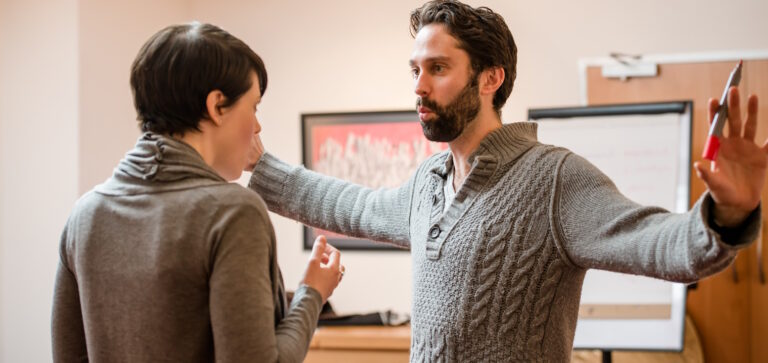
How to Structure a Presentation: Tips for Success
How to structure a presentation? Start with a clear introduction, present your main points, and end with a strong conclusion.
How To Structure A Presentation
How to structure a presentation? Start with a clear introduction, present your main points, and end with a strong conclusion. This simple three-part structure helps you make your presentation better, organise your ideas and keep your audience engaged.
Your introduction tells people what you’ll talk about and why it matters. In the main section, share your key ideas with examples. The conclusion reminds everyone of your main points and suggests what to do next.
This structure works for any presentation, from work meetings to client pitches. It makes your message clear and easy to remember.
Key Takeaways
- Structure your presentation with a clear introduction, main content, and conclusion
- Know your audience and keep them engaged throughout your talk
- Use visual aids like simple slides and pictures to support your key message
- Practice your timing and be prepared to handle questions confidently
Tips For Presentation Success
- Presentation Structure
- Understanding Your Audience
- Using Visual Aids Effectively
- Connecting Emotionally
- Managing Your Time
- Improving Your Presentation Skills
How to Structure a Presentation
Introduction
Your introduction sets the tone for everything that follows, so it’s worth putting some thought into it.
Start by saying hello to your audience. It might seem simple, but a friendly greeting can work wonders for putting everyone at ease – including yourself! Next, introduce your topic. Give your audience a clear idea of what you’ll be talking about. This helps them know what to expect and gets them ready to listen.
Finally, share why your topic matters. Maybe it solves a problem they’re facing, or it could change the way they think about something important. Whatever it is, let them know why they should care about what you’re about to say.
Main Content
Think of your main content like a story. Each point should flow naturally into the next, creating a clear and logical path for your audience to follow. Don’t just list facts – explain why each point matters and how it connects to your overall message.
Remember, people learn in different ways. Some people are visual learners, others prefer hearing things explained. That’s why it’s smart to back up your points with a mix of examples. You might use a quick story to illustrate a point, share some interesting data, or show a relevant picture. This variety keeps things interesting and helps your message stick with different types of listeners.
Conclusion
Wrap up your talk with a memorable finale to make your main ideas stick. An effective ending of your presentation does three key things:
First, it briefly recaps your core points. This reminds folks what matters most.
Next, it clearly tells the audience what you want them to do afterwards. Do you hope they’ll try something new or think about a topic differently? Be specific on the action to take.
Finally, it leaves people with a powerful closing thought to remember, maybe a meaningful quote, thought-provoking question, or conclusion to an earlier story. This final moment often sticks for the longest, so choose it carefully.
The ending is your last chance to make an impact. Use it to drive your message home and inspire your audience to take action. Send them off with a strong finish.
Understanding Your Audience
Know Their Needs
Before you even start planning your presentation structure, take a moment to think about who you’re talking to. Consider these factors about your audience:
- Age range and professional background
- Existing knowledge of your topic
- Interests and motivations
- Potential concerns or questions they might have
Understanding your audience helps you pitch your presentation at just the right level. If you’re talking to beginners, you might need to explain some basic concepts. For an expert audience, you can dive into more complex ideas without losing them. The key is to match your content to their knowledge level so everyone feels like they’re learning something valuable.
Keep Them Engaged
Even the most interesting topic can feel boring if it’s presented in a dull way. That’s why keeping your audience engaged is so important.
One great way to do this is by asking questions. It could be a simple show of hands or a more in-depth discussion question. Either way, it gets your audience thinking and involved in what you’re saying.
You can also try adding some interactive elements to your presentation. Maybe a quick poll using a smartphone app or a brief activity that gets people moving or talking to each other. These little breaks in your talk can help refresh people’s attention and make your presentation more memorable.
Using Visual Aids Effectively
Simple Slides and Pictures
Visual aids can make your talk more interesting and help people understand your ideas better. But using them well takes some thought. When creating impactful presentation slides and choosing pictures, keep these tips in mind:
- Keep slides simple with no more than six lines of text
- Choose clear, relevant images that support your points
- Use high-quality pictures that are easy to see from a distance
- Avoid cluttering slides with too many elements
By following these guidelines, you’ll create visual aids that enhance your presentation rather than distract from it. Remember, the goal is to make your ideas easier to understand and remember.
Videos and Charts
Short videos can be great for showing examples or demonstrating how something works. Just make sure they’re not too long – aim for less than a minute if possible.
Charts and graphs are useful for showing numbers or data in a way that’s easy to understand. But remember, not everyone finds these easy to read. Take a moment to explain what your chart or graph shows and why it’s important.
Connecting Emotionally
Tell Stories
Stories are a powerful way to connect with your audience. They make your talk more interesting and help people remember what you’ve said.
Share your own experiences that relate to your topic. This makes your talk more personal and real. For example, if you’re talking about overcoming challenges, you could share a time when you faced a difficult situation and how you dealt with it.
Using humour can also help. A funny story or joke can lighten the mood and keep people interested. Just make sure your humour is appropriate for your audience and doesn’t offend anyone.
Make a Connection
Looking at your audience while you speak helps create a connection with them. Try to make eye contact with different people in the room. This makes everyone feel included and shows you’re confident about what you’re saying.
Your body language is important, too. Use hand gestures to emphasise your points. Stand up straight and try to look relaxed. This helps you appear confident and makes people more likely to listen to what you’re saying.
Managing Your Time
Timing Your Presentation
Keeping track of time during your talk is really important. If you run over, you might not get to say everything you planned, or worse, your audience might lose interest.
Start by practicing your presentation before the big day. Time yourself to see how long it takes. If it’s too long, you’ll need to cut some parts. If it’s too short, you might need to add more information or examples.
On the day of your presentation, wear a watch or keep a clock where you can see it easily. This helps you stay on track without having to look at your phone, which can be distracting for your audience.
Handling Questions
Many presentations end with a time for questions from the audience. This can be tricky to manage, but it’s a great chance to clarify your ideas and show you know your stuff.
Before your talk, try to think of questions people might ask. Prepare some short, clear answers. This way, you won’t be caught off guard.
When someone asks a question, listen carefully. If you’re not sure what they mean, it’s okay to ask them to explain. Give brief answers to keep things moving, but make sure you’ve fully addressed their question.
Improving Presentation Skills
Giving a good, well-structured presentation takes practice. Here are some ways to get better:
- Plan your content well before you start making presentation slides
- Practice your talk out loud, not just in your head
- Ask friends or family to listen and give you feedback
- Record yourself and watch it back to see how you can improve
- Learn to use pauses effectively – they give your audience time to think
- Work on speaking clearly and at a steady pace
Remember, even experienced speakers get nervous sometimes. The more you practice, the more confident you’ll become.
These skills don’t just help with formal presentations. They can make you better at explaining ideas in class, talking to new people, or even in job interviews later on. So keep working on them – they’re useful in many parts of life!
How Impact Factory Can Help
If you want to get even better at giving presentations, we at Impact Factory can help. We’re experts in teaching people how to speak confidently and share their ideas effectively.
We offer different types of training to help you improve. Our presentation skills course teaches you how to structure your talks and keep your audience interested. We also have storytelling classes that show you how to use stories to make your presentations more engaging.
For those who get nervous speaking in front of others, we have public speaking training. This helps you feel more comfortable and confident when talking to groups.
If you need to convince people or sell ideas, our pitching for business training might be just what you need. It teaches you how to present your ideas in a way that makes people want to listen and agree.
Are you ready to take your presentation skills to the next level? Just give us a call. We’re here to help you become a great presenter, no matter what level you’re starting from.
FAQs
How do I arrange my presentation?
Start with an introduction that tells people what you’ll be talking about. Then, present your main ideas one by one. End with a summary of what you’ve said and what you want people to remember or do.
What are 7 basic steps to deliver a successful presentation?
- Plan your content
- Know your target audience
- Create clear, simple visual aids
- Practice your delivery
- Start strong to grab attention
- Speak clearly and at a steady pace
- End with a powerful conclusion
What are the 7 C’s of presentation?
The 7 C’s stand for:
- Clear – Make your ideas easy to understand
- Concise – Keep it short and to the point
- Concrete – Use specific examples
- Correct – Make sure your information is accurate
- Coherent – Have your ideas flow logically
- Complete – Cover all important points
- Courteous – Be polite and respectful to your audience
What is the 5 5 5 rule for better presentation?
The 5 5 5 rule suggests:
- No more than 5 words per line of text
- No more than 5 lines of text per slide
- No more than 5 text-heavy slides in a row
This rule helps keep your slides simple and easy to read, which helps your audience focus on what you’re saying.
Related Articles:
Here are more tips on how to improve your presentation skills:
- 12 Crucial Tips To Develop Effective Presentation Skills – Follow our tips to reach presentation mastery.
- How to talk like TED – What makes a good TED talk and how can you incorporate these lessons in your presentations?
- The Reason Why Your Workplace Presentation Skills Are So Important – Explore how good presentation skills can affect your career.







